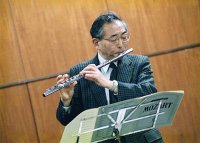 |
 |
|||||||||||||
|
|||||||||||||
|
|||||||||||||
|
“My direct work with Sakue goes back to the early 80s. I was a PhD student at the PETRA electron-positron storage ring at DESY,” says Karlheinz Meier, Professor of the University of Heidelberg. He is also a member of the International Linear Collider Steering Committee, and he chaired the sub-committee to nominate the newly appointed Research Director Sakue Yamada.
Yamada and Meier first worked together at Tokyo University. Their research group developed the electromagnetic shower calorimeter for the JADE experiment, a general purpose particle detector for the PETRA collider at DESY. “I admired Sakue for his deep knowledge of physics, his great competence in instrumentation and his communication skills. I still have this admiration,” Meier says. Yamada's roots are in a mountain area in the Nagano prefecture of Japan. Born in 1941, Yamada's view of the world began to form when World War II was about to end. Even though he was just a little boy, he remembers feeling anxiety about the future. This changed when at the age of 8, Yamada learned that Hideki Yukawa had received the Nobel Prize in physics, the first Japanese Nobel laureate. That was the first link for him to the physics world. Yamada became determined to study physics. He saw a life in science as a beacon in the darkness of post-war Japan. As a boy, he loved working with his hands on small experiments. He assembled and flew model airplanes and made crystal radio sets. Yamada started studying physics in earnest after he entered the Tokyo University. He appreciated the beauty of theoretical physics, but his love for hands-on activities led him to the experimental world. “He was a really serious student,” says Masatoshi Koshiba, one of Yamada's professors at Tokyo University. Teaching wasn't the only role that Koshiba had in Yamada's life though. “I was a matchmaker for him,” Koshiba says. “I remember when Sakue came up to my office one day along with my secretary and reported that they were going to get married.” Yamada participated in numerous international collaborations, especially for the experiments at DESY's particle colliders, DORIS, PETRA and HERA. “I met Sakue and started to work with him on the JADE experiment at the PETRA storage ring around 1976,” says Albrecht Wagner, the Director General of DESY. “In 1979, the gluon was discovered at PETRA, and all of us spent endless hours in front of computer terminals, scanning particle events.” Yamada and Wagner also participated on CERN's LEP experiment, OPAL. As they both lived in Hamburg but had to spend much time in Geneva, they frequently travelled together. In those days cheap flights did not exist though, so they regularly took a 12-hour train ride together. Yamada returned to Japan in the early 80s, but he reunited with Wagner in early nineties when his Tokyo University group joined the ZEUS experiment at DESY. As a result of these activities in Germany, Yamada became a Phillip Franz von Sieboldt Prize winner in 1992, awarded for Japanese researchers who work on German projects. Wagner explains that he and Yamada also always had a connection outside the lab. “We both love chamber music,” Wagner says. Yamada is a flutist, and Wagner is a cellist. Together with Dieter Haidt from DESY, the three of them enjoyed playing Bach sonatas. “I am very pleased that Sakue accepted to become the Research Director for the engineering design phase of the ILC,” Wagner says. “His deep understanding of electron-positron physics, his outstanding experience in optimising detectors for the best physics, as well as his proven leadership and management skills will be of enormous help for completing a convincing Engineering Design Report for both the collider and its detectors.” -- Rika Takahashi |
|||||||||||||
| © International Linear Collider |
